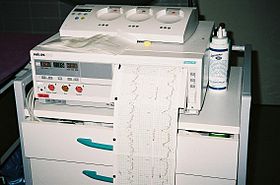| Cardiotocography | |
|---|---|
 A cardiotocograph recording fetal heart rate and uterine contractions | |
| ICD-9-CM | 75.32 |
| MeSH | D015148 |
| CPT | 59050 |
Cardiotocography (CTG) is a technique used to monitor the fetal heartbeat and uterine contractions during pregnancy and labour. The machine used to perform the monitoring is called a cardiotocograph.
Fetal heart sounds were described as early as 350 years ago and approximately 200 years ago mechanical stethoscopes, such as the Pinard horn, were introduced in clinical practice.
Modern-day CTG was developed and introduced in the 1950s and early 1960s by Edward Hon, Roberto Caldeyro-Barcia and Konrad Hammacher. The first commercial fetal monitor (Hewlett-Packard 8020A) was released in 1968.[1]
CTG monitoring is widely used to assess fetal well-being by identifying babies at risk of hypoxia (lack of oxygen).[2] CTG is mainly used during labour.[3][4] A review found that in the antenatal period (before labour), there is no evidence to suggest that monitoring women with high-risk pregnancies benefits the mother or baby, although research around this is old and should be interpreted with caution.[5] Up-to-date research is needed to provide more information surrounding this practice.[5]
A study found that CTG monitoring didn't significantly improve or worsen the outcome, in terms of preventable child death, post birth mortality, of pregnancy for high risk mothers. But the evidence examined in the study is quite old and there have been significant changes in medical care since then.[5]
- ^ Ayres-de-Campos, Diogo (June 2018). "Electronic fetal monitoring or cardiotocography, 50 years later: what's in a name". American Journal of Obstetrics and Gynecology. 218 (6): 545–546. doi:10.1016/j.ajog.2018.03.011. ISSN 0002-9378. PMID 29793572. S2CID 44164963.
- ^ Alfirevic, Zarko; Gyte, Gillian ML; Cuthbert, Anna; Devane, Declan (2017-02-03). Cochrane Pregnancy and Childbirth Group (ed.). "Continuous cardiotocography (CTG) as a form of electronic fetal monitoring (EFM) for fetal assessment during labour". Cochrane Database of Systematic Reviews. 2019 (5): CD006066. doi:10.1002/14651858.CD006066.pub3. PMC 6464257. PMID 28157275.
- ^ Kodkin, Vladimir (2022-07-08). "Cardiotocography in Obstetrics: New Solutions for "Routine" Technology". Sensors. 22 (14): 5126. Bibcode:2022Senso..22.5126K. doi:10.3390/s22145126. ISSN 1424-8220. PMC 9320740. PMID 35890806.
- ^ Park, Tae Jun; Chang, Hye Jin; Choi, Byung Jin; Jung, Jung Ah; Kang, Seongwoo; Yoon, Seokyoung; Kim, Miran; Yoon, Dukyong (July 2022). "Machine Learning Model for Classifying the Results of Fetal Cardiotocography Conducted in High-Risk Pregnancies". Yonsei Medical Journal. 63 (7): 692–700. doi:10.3349/ymj.2022.63.7.692. ISSN 1976-2437. PMC 9226828. PMID 35748081.
- ^ a b c Grivell, Rosalie M.; Alfirevic, Zarko; Gyte, Gillian M. L.; Devane, Declan (12 September 2015). "Antenatal cardiotocography for fetal assessment". Cochrane Database of Systematic Reviews. 2019 (9): CD007863. doi:10.1002/14651858.CD007863.pub4. PMC 6510058. PMID 26363287.